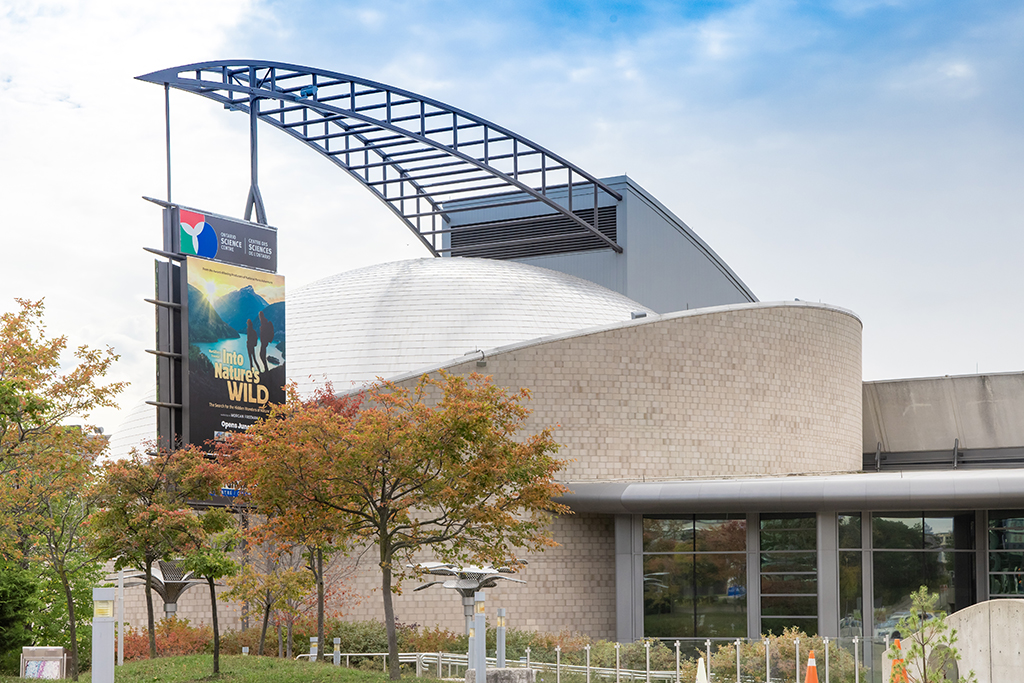The Ontario Science Centre will close to the public after a specialist engineer’s report found “significant structural deficiencies” in the building’s roof.
The Ministry of Infrastructure (MOI) and Ontario Infrastructure provided an update on the current status of the facility, located at 770 Don Mills Road, during a technical briefing today (June 21). According to a recent engineering assessment, some roof structures at the facility were constructed using now-outdated construction materials and systems, as well as deteriorating roof panels.
“Ontario Infrastructure commissioned professional engineers from Rimkus Consulting Group to prepare a report following reports of roof damage in other jurisdictions that used the particular roof panels found at the Ontario Science Centre,” said Michael Robertson, Assistant Minister at the Department of the Interior.
“Based on our findings, the building is at risk of roof damage under the weight of snow this winter. The building will remain safe to occupy until the start of the snow season in late October. However, based on this new information and out of an abundance of caution, the Ontario Science Centre building will be closed to the public today.”
He noted that the immediate closure will allow staff time to safely remove exhibits and transition programs and operations out of the building over the coming months. The facility is scheduled to close by Oct. 31.
Ontario Infrastructure (IO) said it will issue a request for proposals to identify a temporary location for the Ontario Science Centre until a new, permanent site at Ontario Place is ready, adding that the decision is a difficult one, but health and safety is the top priority.
Lindsay reports that science center system is nearing end of life
IO’s president and CEO said issues at the facility were identified in a report released last year.
“I think we all understand that this facility is 55 years old and faces a variety of operational, physical and financial challenges, many of which are detailed in the comprehensive business plan that the government released in November 2023, which details some of the legacy systems that are nearing the end of their useful life and at risk of imminent failure within the next three to five years,” Lindsay explained.
The business plan is based on a building condition assessment conducted by Pinchin Ltd. engineers in April 2022. At the time, experts concluded that at least $478 million in capital renovations were needed to repair and replace the current facility’s outdated infrastructure.
Then in the fall of 2023, stories began to emerge, particularly from the UK, about reinforced autoclaved aerated concrete, a lightweight concrete that was a popular building material from the 1950s through the 1970s.
“The advantage of this particular type of concrete was that it was a lightweight construction, but it then became apparent that this type of concrete was particularly susceptible to flooding,” Lindsay explained. “Stories began emerging of roof structures built with this type of concrete being damaged.”
As Lindsay recalls it, they quickly engaged Rimkus Consulting to discuss installing RAACs in each of the three main buildings that make up the Ontario Science Centre facility.
“The conclusion of the study, which has now been presented to us, in the formal report, is that RAAC is used on a significant amount of roof area across all three Science Center buildings,” Lindsay explained. “In fact, 54 percent of the total roof area at the Science Center is RAAC.”
He said enhanced stormwater monitoring and roof maintenance processes will ensure the building remains safe through the summer.
“We have been able to mitigate that risk, but the reality is that the Science Centre roof is now at the end of its life and the RAAC panels on the roof will need to be replaced in their entirety,” Lindsay said. “Rimkus engineers have been very clear that the roof will need to be repaired or replaced before people can finally get inside the building, which will be by October 31st of this year anyway.”
This information was provided to the government to help with decision-making, he added.
“This is a very significant construction job,” he said. “Just imagine, we have to take the roof off every building at the Ontario Science Centre, remove all the RAAC paneling and eventually replace it with steel decking.”
He added that the building presents unique construction challenges when it comes to getting inside to carry out these works.
“Based on Rimkus’ preliminary estimates, final completion of these repairs could cost $40 million and take anywhere from two to five years or more. Additionally, repairing or replacing the roof at the Ontario Science Centre would require the facility to be emptied in any event,” Lindsay said.
Construction underway at new Ontario Place facility
Earlier this year, IO issued a request for qualifications to begin a procurement process to identify a team to design, build, finance and maintain the new Ontario Place facility, scheduled to open in 2028.
The Ontario government’s decision to move the building has been somewhat controversial, and critics have questioned the timing of the report’s release, but Lindsay said “this is absolutely a health and safety issue.”
“We have professional engineers here who have given us a stamped and sealed engineering report with instructions on the condition of the facility,” Lindsay said. “The peer review will be done by an entity called Van Boxmeer & Stranges Engineering, Inc. This is standard engineering protocol and will be followed here.”

